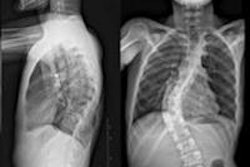Patients lying supine for lateral lumbar spine examinations will receive a higher x-ray dose under single automatic exposure control and without tube potential change than if they had been lying on their side, U.K. researchers have found.
Looking at the dose-area product (DAP) meter attached to x-ray units at the emergency department of the Queen Alexandra Hospital in Portsmouth showed the dose values for exams performed on the x-ray table with a vertical x-ray beam were significantly lower than those for exams of patients on a trolley using a horizontal beam. Anne Davis, from the medical physics department at the hospital, and colleagues investigated the differences in the two techniques with a view to optimize exposure conditions (British Journal of Radiology, 7 May 2013).
In their study, 20 patients weighing between 50 kg and 90 kg underwent lateral lumbar spine radiographic examinations in the emergency department (Axiom Aristos FX Plus, Siemens Healthcare). The target angle for the x-ray tube was 12° and the measured ripple for tube potential was in the region of 1%. A single automatic exposure control (AEC) system was available for use in the undertable or vertical position.
The AEC system had been set to deliver a detector dose in the range of 1.8 mGy to 2.2 mGy. For the vertical beam technique, the DAP ranged from 0.2 Gy cm2 to 4.6 Gy cm2, whereas the horizontal beam technique produced a DAP from 0.8 Gy cm2 to 7.2 Gy cm2. Radiographic staff suggested that rotating patients from lying on their side to their back would increase the tissue thickness in the lumbar region of the trunk. A group of volunteers were measured to establish the typical lateral thickness and the variation in thickness in this region for the two orientations.
Results showed the tube potential needed to be increased from 93 kV to between 113 kV and 117 kV to compensate for the increase in lateral body thickness to match the delivered mAs, Davis and colleagues noted. Radiographers chose to increase the tube potential for horizontal beam lateral lumbar spine projections to 102 kV.
"This was a conservative choice of the tube potential to ensure that the radiographic contrast remained satisfactory," they wrote. Following the tube potential increase, the DAP ranged from 0.8 Gy cm2 to 8 Gy cm2, showing a reduction of 15% for the average DAP compared with the lower tube potential technique. In addition, a senior radiographer determined there was no detrimental effect on the image contrast owing to the tube potential increase.
"Patients who require lateral lumbar spine examinations while lying supine will receive a higher exposure, under AEC and without tube potential change, than if they had been lying on their side," the authors explained. "This is because of the increased tissue thickness in the x-ray beam path."
The measured DAP values will increase by a factor of at least two for an average-size patient unless the tube potential is increased.
"The results of this work highlight the importance of fully understanding the detail of the radiographic technique in use when a patient dosimetry audit is carried out," they wrote. "Radiographic staff should be aware of the impact that the use of a horizontal beam may have on the patient dose."
In addition, radiographers should routinely increase the tube potential for larger patients. The tube potential increase partially compensates for the increase in lateral thickness that occurs when the patient is in the supine position for the horizontal beam technique.
Hospitals in the U.K. are required to monitor the dose levels for groups of standardized patients undergoing common radiographic examinations under the Ionizing Radiation (Medical Exposure) Regulations 2000. Under the law, when mean values of measured doses exceed the locally defined diagnostic reference level, the cause is investigated and corrective action is taken. The U.K.'s current recommended national diagnostic reference level (NDRL) for the lateral lumbar spine is 2.5 Gy cm2.
The U.K.'s current recommended NDRL for the lateral lumbar spine was derived from data in which the distinction was not made between the horizontal and vertical beam techniques, according to Davis and colleagues.
Their study identified that because of increased tissue volume, DAP values from the horizontal beam technique will be higher than those from the vertical beam technique. The extent of this difference will depend on the tube potential chosen for the horizontal beam technique.
"In this study, the average DAP values were 2.3 Gy cm2 for horizontal beam and 1.3 Gy cm2 for vertical beam techniques," they wrote. "It is therefore recommended that separate local DRLs are set for the two techniques."



















